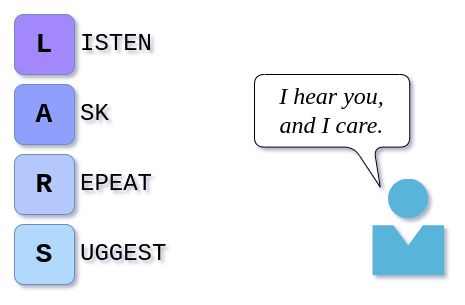Listening to Understand: The LARS Approach for Improved Conversations
Meta Info

Problem Statement
You have difficulties connecting with others, and find yourself disengaged during conversations.
Intent
- Be fully present, focusing on understanding your conversational partner.
- Improve your relationships by practising empathetic listening.
- Prioritize listening to understand, rather than simply responding.
Contextual forces
Enablers
The following factors support effective application of the practice:
- Genuine care for the person you’re conversing with and a desire to understand them.
- The topic of conversation is interesting or relevant to you.
- Ability to stay calm and present during conversations.
Deterrents
The following factors prevent effective application of the practice:
- Your own thoughts are overwhelming, making it difficult to empathize with others.
- Formal situations where monologue-style speaking is expected (e.g., work presentations or job interviews).
- Your main job is to solve various problems quickly, and without much interaction (e.g. remote tech support).
- You do not particularly care for the person you are conversing with.
- Feeling rushed during the conversation.
Solution
Instead of defaulting to responding, practice empathetic listening using the LARS acronym:
(L)isten: Actively listen to what the other person is saying, resisting the urge to formulate a response immediately. If you find your mind drifting, take a deep breath, and refocus on their words. Non-verbal cues like nodding or acknowledging sounds (“aaahhh” , “hm, hm”, “I see”) can help1.
(A)sk: Engage your conversational partner by asking questions about their perspective, feelings, and needs. This signals your genuine interest and deepens your understanding. Strike a balance between being interested, and interrupting them too often. Try to avoid overwhelming them with excessive questions, and making your conversational partners feel as if they are being interrogated2.
(R)epeat: Validate your understanding by paraphrasing what you’ve heard in your own words. Confirm with your partner that your summary aligns with their message. This reinforces that you’ve genuinely heard and comprehended their words. You can use a variation on one of these formulations to do so: “If I understood correctly …”, “Let me get this straight, you are saying that…”, “So as I understood it, you … . Does that sound right?”, “I will try and summarize to see if I understood correctly, …”.
(S)uggest: After understanding their perspective and needs, offer suggestions or assistance thoughtfully. Ensure your suggestions align with their concerns without trivializing their feelings or experiences. Little is more painful than sharing your feelings, only to be told that you are likely overreacting. Avoid using trivializing words, and platitudes, such as “just”, “easy”, “we’ve all been there”, “that’s nothing, you should hear what I went through”.
Rationale
In Western society, we often prioritize responding and asserting ourselves in conversations3. However, most people seek conversation for reasons like seeking empathy, getting someone to act, or receiving information. Empathetic listening, defaulting to an “empathy mode,” is usually the key to meaningful connections. When someone talks to you, assume they want to be heard. If in doubt, politely ask what they expect from the conversation.
Examples
Take a moment to tune in to popular talk shows and interview-focused podcasts. Pay close attention to how the hosts skilfully bring out the best in their guests. The best hosts have a unique talent for getting their guests to open up, creating an atmosphere where the guest shines and feels like the most captivating person in the world.
Now, let’s contrast this with the style of “pundits” or “talking heads” on shows that thrive on hot takes, monologues, and criticism of current events or famous individuals. Think about sports shows or political debate programs – they often fit this description perfectly.
Now, consider this: If you were to be interviewed, who would you prefer to be your host? Someone who genuinely aims to make you shine, or someone who seems more interested in tearing you down?
Here’s the real question: What type of host do you aspire to be in your own conversations? The answer may hold the key to more meaningful and impactful interactions.
Further Exploration
- Abrahams, M. (2023). Think Faster, Talk Smarter. S&S/Simon Element. isbn: 9781668010303.
https://www.goodreads.com/book/show/101144770-think-faster-talk-smarter. - King, P. (2020). The Art of Captivating Conversation. Skyhorse Publishing. isbn: 9781510729063.
https://www.goodreads.com/book/show/50041015-the-art-of-captivating-conversation. - Rosenberg, M.B. (2015). Non-violent Communication: A Language of Life. PuddleDancer Press. isbn: 9781892005281.
https://www.goodreads.com/book/show/25073935-nonviolent-communication.
Individuals who struggle with staying “passive” physically or verbally can try techniques like fidgeting with noiseless objects or engaging in doodling or note-taking during conversations to maintain focus. ↩︎
Finding the right balance in asking questions depends on your conversational partner’s preferences. Pay attention to their cues, practice, and consider asking them when in doubt. ↩︎
For instance, political debates often highlight participants’ focus on asserting their viewpoints rather than truly listening, building on top of, or responding to arguments made by other participants. ↩︎
